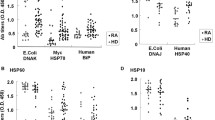Abstract.
Heat shock proteins (hsp) are highly conserved, immune-dominant microbial proteins, whose expression is increased at sites of inflammation. In the experimental model of adjuvant arthritis (AA) immune responses to hsp determine the outcome of disease. AA can be transferred with a single T cell clone specific for a sequence of mycobacterial hsp65 (Mhsp65). Immunization with whole Mhsp65 on the other hand, protects in virtually all forms of experimental arthritis, including AA. This protective effect seems the consequence of the induction of a T cell response directed against self-hsp60. A similar protective effect of self-hsp60-specific T cells seems present in patients with a spontaneous remitting form of juvenile idiopathic arthritis. Next to hsp60, other hsp have similar protective effects in arthritis, while other conserved microbial proteins lack such capacity. Nasal administration of hsp60 peptides induces IL-10-driven regulatory T cells that are highly effective in suppressing arthritis. Thus hsp60, or peptides derived from hsp60, are suitable candidates for immune therapy in chronic arthritis.
Similar content being viewed by others
Author information
Authors and Affiliations
Rights and permissions
About this article
Cite this article
Prakken, B.J., Roord, S., Ronaghy, . et al. Heat shock protein 60 and adjuvant arthritis: a model for T cell regulation in human arthritis. Springer Semin Immunopathol 25, 47– 63 (2003). https://doi.org/10.1007/s00281-003-0128-7
Issue Date:
DOI: https://doi.org/10.1007/s00281-003-0128-7




